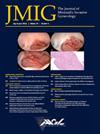成功切除剖宫产瘢痕异位伴闭塞前腔窦的技巧和窍门
IF 3.5
2区 医学
Q1 OBSTETRICS & GYNECOLOGY
引用次数: 0
摘要
研究目的描述剖宫产瘢痕妊娠(CSP)的分类。展示外源性瘢痕妊娠(CSP)和前穹隆闭锁妊娠(CSP)切除术的技巧和窍门。患者或参与者35岁、妊娠9周零6天、孕4宫3段的女性,因阴道出血到急诊就诊。干预措施机器人辅助切除 IIIA 型剖宫产瘢痕异位妊娠,同时剥离闭塞的前穹隆和暂时性子宫动脉闭塞。演示了从外侧和内侧入路进行腹膜后剥离,以便从子宫动脉起源处进入,进行暂时性闭塞。还讨论了从外侧到内侧的方法,即从圆韧带前方的无血管空间开始解剖,从而进入阻塞的蝶窦。在形成致密瘢痕之前溶解丝状粘连可能有助于安全剥离。在腹腔镜引导下放置子宫操作器可防止异位妊娠破裂和急性出血。在子宫血管前方识别宫颈杯可以更好地围绕异位妊娠进行剥离,减少膀胱、异位妊娠或子宫血管损伤的机会。之前的剖宫产手术造成的粘连大多发生在子宫下段,在致密的子宫下段粘连下形成一条隧道,将膀胱与异位妊娠分离。倾斜 30 度的显微镜可能有助于充分观察前方剥离情况。本视频展示了成功切除 IIIA 型外源性剖宫产瘢痕异位妊娠的技巧和窍门。本文章由计算机程序翻译,如有差异,请以英文原文为准。
Tips and Tricks for Successful Resection of Cesarean Scar Ectopic With an Obliterated Anterior Cul De Sac
Study Objective
To describe the classification of cesarean scar pregnancies (CSP). To demonstrate tips and tricks for resection of exogenous CSP with an obliterated anterior cul de sac.
Design
Surgical educational video.
Setting
Procedure performed under general anesthesia with robotic assistance. Patient in dorsal lithotomy position.
Patients or Participants
35 years old gravida 4 para 3 women at 9 weeks and 6 days gestation who presented to the emergency room with vaginal bleeding. Her BHCG was 9,506mIU/mL, she had a history of 3 prior cesarean sections, and a BMI 41.
Interventions
Robotic assisted resection of type IIIA cesarean scar ectopic pregnancy with dissection of obliterated anterior cul de sac and temporary uterine artery occlusion.
Measurements and Main Results
This video demonstrates various strategies to safely navigate these complex cases. Retroperitoneal dissection with a lateral and a medial approach are demonstrated in order to access the uterine artery at its origin for temporary occlusion. A lateral to medial approach to the obliterated cul de sac by starting the dissection in the avascular space anterior to the round ligament is discussed. Lysing filmy adhesions prior to dense scar may assist in safe dissection. Placing a uterine manipulator under laparoscopic guidance may prevent disruption and acute bleeding of the ectopic pregnancy. Identifying the cervical cup anterior to the uterine vessels allows for better dissection around the ectopic pregnancy and decreases the chance of bladder, ectopic, or uterine vessel injury. Most adhesions from prior cesarean sections happen at the lower uterine segment and a tunnel is developed under the dense lower uterine segment adhesions to separate the bladder from the ectopic pregnancy. An angled 30-degree scope may help with adequate visualization for the anterior dissection. Back-filling the bladder is useful to determine the boarders of a safe dissection.
Conclusion
This video demonstrates tips and tricks for successful resection of type IIIA exogenous cesarean scar ectopic pregnancy.
求助全文
通过发布文献求助,成功后即可免费获取论文全文。
去求助
来源期刊
CiteScore
5.00
自引率
7.30%
发文量
272
审稿时长
37 days
期刊介绍:
The Journal of Minimally Invasive Gynecology, formerly titled The Journal of the American Association of Gynecologic Laparoscopists, is an international clinical forum for the exchange and dissemination of ideas, findings and techniques relevant to gynecologic endoscopy and other minimally invasive procedures. The Journal, which presents research, clinical opinions and case reports from the brightest minds in gynecologic surgery, is an authoritative source informing practicing physicians of the latest, cutting-edge developments occurring in this emerging field.

 求助内容:
求助内容: 应助结果提醒方式:
应助结果提醒方式:


